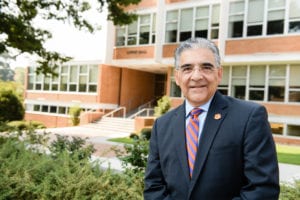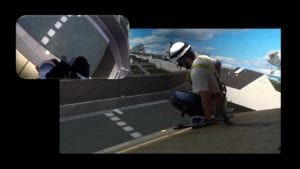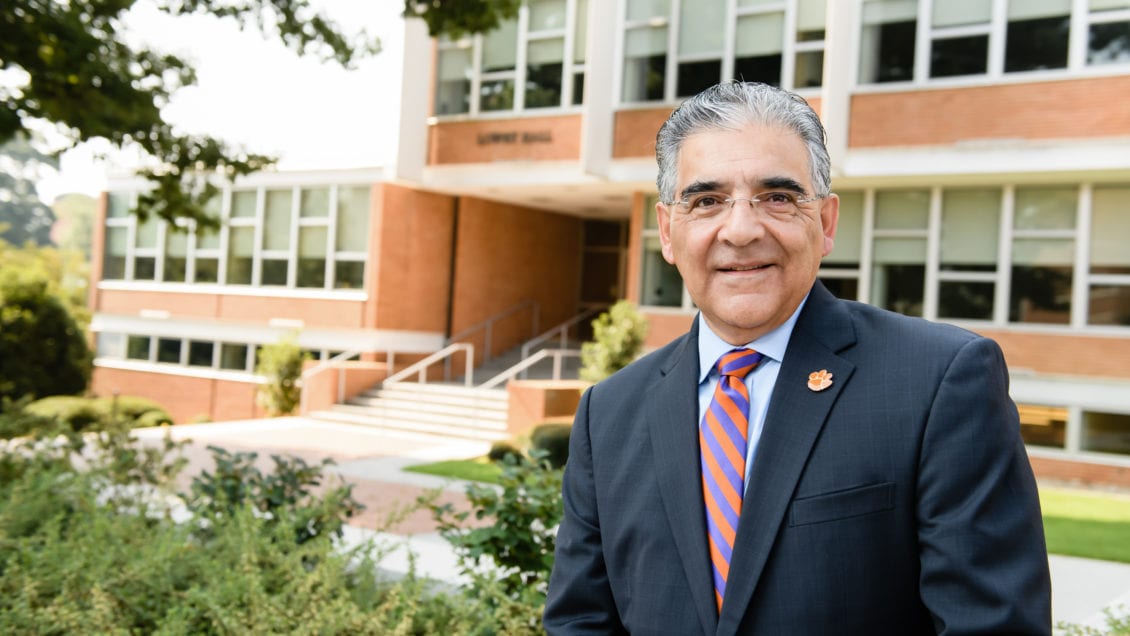It would seem that providing construction workers with more training and safety equipment would help prevent injury, but Jesus M. de la Garza of Clemson University said it may not be so simple.
Research he led showed evidence that when safety measures are put in place, workers take more risks without even knowing it because they feel safer. The upshot is that construction workers need more education so they will be aware of their heightened risk tolerance, de la Garza said.

The research is one of the latest examples of why de la Garza is winning a 2021 Outstanding Projects And Leaders (OPAL) Award from the American Society of Civil Engineers (ASCE).
de la Garza serves as the chair of the Glenn Department of Civil Engineering, where he leads 28 faculty members and oversees the education of 500 undergraduate and graduate students.
The ASCE award is in the construction category and recognizes him for “innovation and excellence in construction of civil engineering projects and programs” over a career spanning more than three decades.
de la Garza said it’s his highest honor.
“I believe that the best years of my life are in front of me,” he said. “I intend to earn this amazing and humbling distinction every single day. Furthermore, one does not get to this stage alone. I believe that this distinction belongs to the village of all my mentors, colleagues, students, and family who have scaffolded me.”
Greater heights
de la Garza joined Clemson in August 2019 after more than three decades at Virginia Tech. He is now primarily focused on helping faculty, staff and students be as successful as they want to be.
“There is nothing I do for me anymore—I did that for more than three decades at Virginia Tech,” he said. Now, it’s all about empowering and leveling the field for others. My job is to lead and to pay it forward.”
Anand Gramopadhye, dean of the College of Engineering, Computing and Applied Sciences, said the ASCE award is well-deserved.
“The award is a testament to the impact that Dr. de la Garza has had in his career and the level of scholarship and leadership he has brought to the college,” Gramopadhye said. “I offer him my deepest congratulations.”

When de la Garza became chair, he set a goal of taking the department to greater heights. As part of that goal, he is now working to create a School by merging the Glenn Department of Civil Engineering with the Department of Environmental Engineering and Earth Sciences.
Together, the departments will form a school within the College of Engineering, Computing and Applied Sciences.
“The school will accelerate our quest for higher ground,” de la Garza said. “However, both departments share a common problem– dated teaching laboratories. To get to the next higher ground, we must renew the teaching laboratories to produce graduates that are career-ready engineers.”
JEDI report card
de la Garza is also working to establish several programs aimed at fostering student engagement, cultivating a sense of community, a heightened sense of belonging and a strong sense of engineering development.
The efforts include a Justice, Equity, Diversity, and Inclusion (JEDI) report card. de la Garza is also working to weave an “alumni everyday” philosophy into the department’s routine, a process aimed at creating not just graduates but “Clemson Multipliers” who continue to give back to their alma mater long after they leave campus.
“We are focused on producing career-ready engineering professionals prepared to have a global impact,” de la Garza said, “and we are focused on partnering with alumni and friends to underpin society by addressing its grand challenges through learning and discovery.”
Under de la Garza, the department is encouraging undergraduates to participate in research, especially through the Creative Inquiry program. The number of credit hours that undergraduates can double-count to fulfill Bachelor of Science and Master of Science degrees has increased to nine.
“This is an amazing strategy which allows qualified students to obtain their master’s degree within one year after receiving their bachelor’s degree,” he said. “This strategy is also aligned with National Science Foundation’s Broader Impacts, which calls for us to increase the number of students who pursue graduate education.”
The department is also in the midst of allowing students to participate in capstone projects as sophomores and juniors instead of waiting until senior year. The projects give them the chance to work on real-world challenges.
It’s part of the department’s Arch RED program, funded with $2 million from the National Science Foundation’s Revolutionizing Engineering and Computer Science Departments program.
“The Arch RED initiative is implementing Leonardo da Vinci’s philosophy– imagining the end before starting,” de la Garza said. “We believe that this strategy will help not only produce career-ready engineers, but also will go a long way in instilling in our students an enhanced engineering identity.”
Measuring risk-taking
de la Garza’s construction-safety research is aimed at preventing injury in jobs that have sometimes proven hazardous to workers.
The fatality rate due to falls to a lower level in the construction industry is eight times higher than the average fatality rate in all other industries, according to 2019 research by The Center for Construction Research and Training.
Falls account for more than 40% of construction fatalities, according to a 2017 report from the U.S. Bureau of Labor Statistics.
For their research, de la Garza and his collaborators had 33 student volunteers, standing in as entry-level roofing industry workers, put on head-tracking goggles and an ankle-tracking bracelet.
Four 3D displays and eight projectors made it look like they were on the second-story of a residential building. Wind and sound-effects filled the room to enhance the realism.
The students were asked to install asphalt roofing shingles on a real-world section of a 27 degree pitched roof placed on the floor—creating a mixed reality environment. They worked under three experimental conditions: wearing typical personal-protective equipment that included a hard hat, gloves and knee pads; adding a fall-arrest system; and adding both a fall-arrest system and a guardrail.
After completing one of the conditions, students were given a 15-minute break during which they were asked to fill out several surveys and complete a computerized risk-taking behavior assessment game.
When students completed all three conditions, researchers interviewed the students to investigate their changes in risk perception under each condition and to assess the extent to which the student felt present in the environment.
“The results yielded unequivocal evidence of risk compensation; participants responded to more fall protection by showing more reckless and risky behaviors,” researchers wrote in “Latent Effect of Safety Interventions,” a paper published last year in ASCE’s Journal of Construction Engineering and Management.
Co-authors on the study were de la Garza; Sogand Hasanzadeh, then a Ph.D. candidate in the Department of Civil and Environmental Engineering at Virginia Tech and now an assistant professor at Purdue University; and E. Scott Geller, a psychology professor at Virginia Tech.
The research is getting some momentum. de la Garza said he has been interviewed by two trade publications about the research, and he’s watching for the articles, due out soon.
‘This is home’
de la Garza said that in addition to his research and other programs in the Glenn Department of Civil Engineering, the department is also working on a strategic plan with input from faculty, staff, students, and alumni.
“I can’t wait to get past COVID and resume a vibrant campus atmosphere,” de la Garza said. “While I will always be loyal and grateful to the Tec de Monterrey Borregos, the University of Illinois Illini, and the Virginia Tech Hokies, I’m very proud now to be a Clemson Tiger. This is home!”
Get in touch and we will connect you with the author or another expert.
Or email us at news@clemson.edu

